34+ Types Of Palm Trees In Florida
Florida is a palm tree paradise, with over a dozen species to be found within its borders. Each of these species has unique characteristics that set it apart from others, including differences in height, leaf shape, trunk texture, and growth habits. In this post, we’ll delve into the world of Florida’s palm trees, exploring the various species that can be found in the state. From the African Oil Palm to the Windmill Palm, we’ll cover all 34 species that call Florida home.
For those looking to add some tropical flair to their landscaping or simply curious about what types of palms grow in Florida, this post is for you. We’ll start by answering the question on everyone’s mind: how many kinds of palm trees are found in Florida? The answer may surprise you. We’ll also explore the various ways to identify a palm tree in Florida, from its stem and fronds to its fruits and trunk.
Of course, no discussion of palm trees would be complete without covering some of the most iconic species found in Florida. From the majestic Royal Palm to the humble Saw Palmetto, each of these species has its own unique characteristics that make it special. And for those looking to add a touch of exoticism to their landscape, we’ll explore some of the most famous palm tree species in Florida.
So whether you’re a palm enthusiast or simply looking to learn more about the fascinating world of palms, this post is sure to provide something of interest.
How many kinds of palm trees are in Florida?
Florida boasts an astonishing array of over 30 palm tree species, primarily as a result of the tourism and hotel industries’ significant growth. However, this impressive diversity belies the fact that there are only 12 native palm tree species that originated within the state’s borders. The remainder hail from Southeast Asia and South America.
Despite this, Florida’s unique palm tree offerings make it a genuine ‘palm tree state’, boasting an extraordinary selection of species that are sure to impress.
What are the 12 native palm trees in Florida?
Among the numerous palm trees found in Florida, only 12 species are widely regarded as native to the state.
While some species may be contested as Florida natives due to their presence in other regions like Australia and Asia, here is a list of the palm tree species that are officially recognized as native to Florida: Dwarf palmetto, Scrub palmetto, Saw palmetto, Needle palm, Sylvester palm, Keys thatch palm, Florida thatch palm, Florida silver palm, Paurotis palm, Alexander palm tree, Cabbage palm, and Florida royal palm.
How do I identify a palm tree in Florida?
When trying to spot a palm tree, there are certain distinct features to keep an eye out for. The following unique characteristics can aid in accurately identifying this type of tree:
Stems
Palm trees are characterized by their distinctive stems, which often feature old leaf bases, also known as fronds, that grow in a bushy or fan-shaped pattern along the trunk. This unique characteristic serves as a strong identifying feature for palm species, particularly when compared to coconut palms, which lack this characteristic. The presence of fronds on the stem is a key indicator of a palm tree’s botanical identity.
Fronds
Palm trees showcase a remarkable diversity in the appearance of their leaves, also known as fronds. A notable characteristic is the shape and structure of these fronds, with different species exhibiting distinct patterns. Pinnate fronds, resembling feathers, are a common feature of the date palm, coconut palm, Areca palm, and Queen palm. In contrast, palmate fronds take on a fan-like shape, seen in the Mexican and Chinese fan palms, as well as the Windmill palm and Bismarck palm.
Fruits
While it’s true that some palm species don’t produce fruit, the majority do. In fact, many palms are known for their edible fruits, such as coconuts, betel nuts, or even acai berries. So, if you come across a tree with one of these types of fruits, there’s a good chance it’s a palm. The presence of fruit is often a telltale sign that the tree is indeed a member of the palm family.
Trunk
The characteristic appearance of palm tree trunks is often likened to a woven pattern, with individual stems intersecting each other in a crisscross fashion. As you gaze up from the base of the trunk, you’ll notice that its surface becomes increasingly rough and spiny before gradually smoothing out towards the top. However, not all palms conform to this pattern; some boast straight trunks, while others feature tapered or irregular shapes, adding to their unique charm.
Flowers
Palm trees, often characterized by their understated floral displays, produce blooms in a range of hues – from pure white to subtle shades of gray. While some varieties emit fragrant scents, others remain scentless. Interestingly, the presence of flowers on a palm tree is often indicative that it will go on to produce coconuts.
Height
While dwarf species of palms are generally no taller than 10 feet, their larger counterparts can reach astonishing heights. In fact, some varieties of palms can grow up to an impressive 100 feet tall, making them a striking feature in any landscape.
Types of palm trees in Florida
Florida is home to over 30 endemic species of palm trees, but it’s the well-known varieties that often capture people’s attention. When driving through or flying into the state, common sights include a range of iconic palms. These familiar faces are a testament to Florida’s unique botany and a delight for those who appreciate the beauty they bring.
African Oil Palm (Elaeis guineensis)

While often viewed as a decorative element, the African oil palm tree holds much more significance than just its aesthetic appeal. It remains a primary source of palm oil, providing the world’s population with a vital cooking ingredient. Additionally, this versatile plant plays a culturally important role in many African communities. In terms of physical characteristics, the African oil palm tree typically grows to be between 20-60 feet tall.
Its small flowers give rise to red oval fruits that measure approximately 4cm in size. As these fruits ripen, they turn from red to black, and it is at this stage that the valuable palm oil is extracted.
Alexander Palm (Archontophoenix alexandrae)

The Sabal palmetto, also known as the Cabbage Palm or Palmetto, is a popular choice for landscaping in Florida’s warm climate due to its unique characteristics and adaptability. Its smooth trunk features a multi-stemmed design with a prominent central bulge, and it boasts an intriguing self-cleaning nature that keeps its fronds tidy. The leaves are pinnate in shape, with a natural arching growth habit that adds visual interest.
When mature, the fronds can reach impressive lengths of up to 8 feet, while the overall height of the palm tree typically ranges from 20 to 40 feet tall. One of its notable features is its relative cold hardiness, able to thrive even in temperatures as low as 4 degrees Celsius.
Areca Palm (Dypsis lutescens)
A palm species that’s gained widespread popularity for its indoor appeal is now classified as endangered. Notably, its growth pattern bears a striking resemblance to bamboo, with a tendency to clump. The Areca palm’s trunk boasts a smooth texture, occasionally displaying warm golden hues. Its slender and narrow fronds add to the plant’s visual charm.
Arecas are notoriously slow-growing, making them an ideal choice for container cultivation.
Spring is generally considered the best time to plant them, as this allows for optimal establishment and growth. When mature, these palms can reach impressive heights of 10-30 feet, with a width of approximately 8-15 feet, making them a great option for indoor spaces.
Bismarck Palm (Bismarckia nobilis)

While not a native Florida species, the silver gray palm is a popular choice for southern states due to its unique characteristics. Its short, fibrous trunk stands out, paired with a striking frond and bushy crown that boasts a silvery hue. The palm’s leaves are palmate in shape and can reach lengths of up to 10 feet, while the crown cover measures as large as 22 feet in diameter. When mature, this palm can grow to heights of up to 20 feet.
Bottle Palm (Hyophorbe Lagenicaulis)

The Bottle Palm’s distinctive feature is its bottle-shaped trunk, which sets it apart from the Spindle Fan Palm. Despite being a small-sized palm, it appears wide and bulky due to this unique shape. At 10ft in height, it has four large pinnate leaves that can reach up to 12ft at their maximum length. This compact size makes it an ideal candidate for container growing, allowing you to bring it indoors during the winter months and enjoy its tropical charm year-round.
Buccaneer Palm (Pseudophoenix sargentii)

The Florida cherry palm, also known as the palmetto, is a medium-sized palm species that reaches a maximum height of approximately 26 feet. One of its defining characteristics is the unique shape of its long fronds, which grow in an arching habit. The trunk of this palm is swollen and smooth, featuring ringed patterns along its surface. Due to its container-friendly nature, the Florida cherry palm can be easily moved indoors during the winter months.
Cabbage Palm (Sabal Palmetto)

The Blue Palmetto, also known as the swamp palm or blue palmetto, has a unique place in the natural world. Native to the Bahamas, Cuba, and Florida, it holds a special significance as the official state tree of Florida. This majestic plant can grow up to 65 feet tall, showcasing its impressive stature. Its remarkable tolerance for salt, drought, and snow makes it an ideal candidate for various environments. One of the key reasons it’s cherished is its exceptional disease resistance.
The Blue Palmetto’s distinguishing feature lies in its tan trunk, adorned with old leaf bases and crisscross patterns that gradually transform into a smooth gray color as you move towards the top. Its fan-shaped leaves tip off with white and fragrant flowers, while its black, edible fruits provide a sweet treat. This remarkable plant is truly a marvel of nature.
Canary Island Date Palm (Phoenix Canariensis)

The Canary Island Date Palm, also known as the pineapple palm, is a unique flowering palm that hails from the Canary Islands. Its trunk takes on an intriguing pineapple-like shape, growing up to 30 feet in diameter. Reaching heights of 65 feet with a spread of 40 feet, this palm boasts long, dark green pinnate leaves measuring 20 feet in length. Be cautious when approaching its base, as it features sharp pine-like structures.
After blooming, the pineapple palm produces ornamental white-gray flowers and yellow, edible fruits.
Chinese Fan Palm (Livistona Chinensis)

The Chinese Windmill Palm (Trachycarpus fortunei), a non-native species, has its origins in China, Japan, and Taiwan. While it thrives in South Florida’s climate, its rapid growth rate poses concerns about potential invasiveness in certain regions of the state. As a result, its cultivation is carefully regulated to prevent unwanted spread. In ideal conditions, this palm can reach impressive heights of up to 50ft, with a lateral span of approximately 12ft.
Its unique leaves are bluish-green in color and grow up to 6ft long, featuring a rounded and segmented structure. Upon blooming, the Chinese Windmill Palm produces bright yellow flowers, which give way to blue-green or black fruit.
Christmas Palm (Adonidia merrillii)

The Christmas palm, a standout dwarf palm species, effortlessly elevates any ornamental garden with its unique charm. In fact, it’s widely regarded as the most sought-after dwarf palm among enthusiasts and homeowners alike. Reaching a maximum height of 25 feet, this palm is distinguished by its upward-arching, large pinnate leaves that add a touch of elegance to any setting.
Its festive reputation stems from the bright red fruits it produces during the winter months, making it an ideal choice for those seeking to incorporate a touch of holiday cheer into their outdoor spaces.
Coconut Palm (Cocos Nucifera)

The majestic palm tree, affectionately dubbed the ‘tree of life’, is a treasured symbol of island culture. Its fruit is not only a refreshing source of juice but also boasts a nutritious interior. This versatile palm is one of the most widely cultivated in Florida, with some specimens reaching heights of up to 80 feet. Additionally, it can thrive in containers, reaching a maximum height of around 20 feet.
Notably, the tree’s crown is often characterized by a lush, bushy arrangement of pinnate leaves, comprising at least 30 leaflets. Interestingly, with proper care, you can start harvesting coconuts as early as 4-6 years after planting.
Fishtail Palm (Caryota mitis)
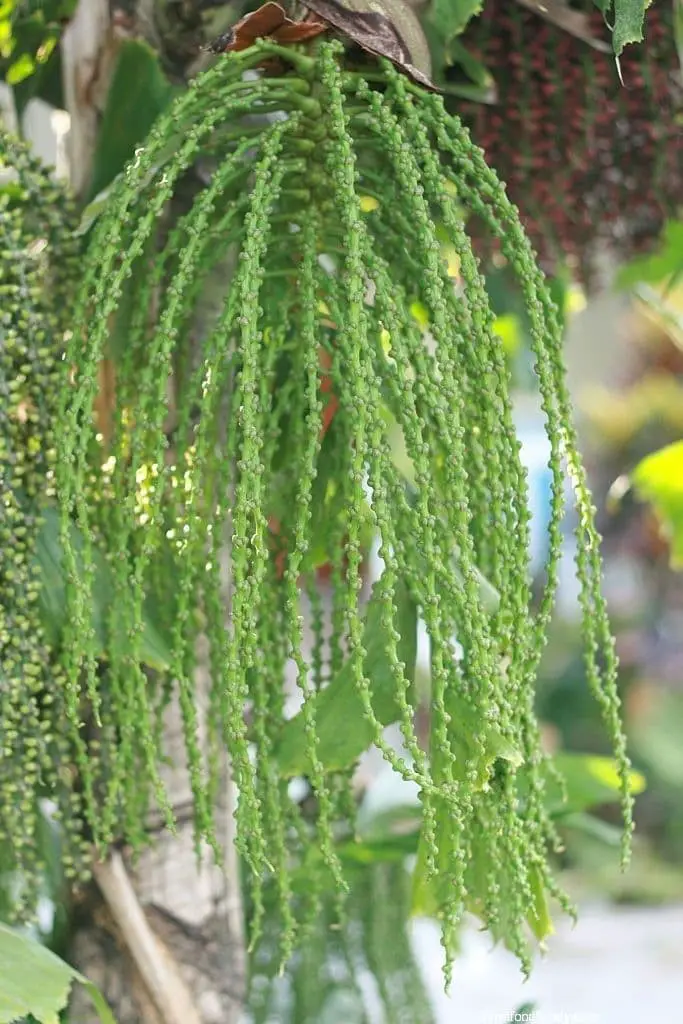
The Fishtail Philodendron’s unique characteristic lies in its shaggy leaves that resemble a fishtail shape. This adaptable plant is capable of thriving in arid environments, growing up to 20ft tall with a width ranging from 10-35ft. Its low maintenance requirements are further highlighted by the blue-green color and shiny undersides of its leaves. The Fishtail Philodendron’s optimal climate range lies within subtropical to tropical zones, where it can reach its full potential.
Florida Silver Palm (Coccothrinax argentata)

In the southern region of Florida, there’s a unique type of palm that calls this area home. Characterized by its slender and smooth trunk, which can grow anywhere from 6 to 20 feet tall, this palm is a sight to behold. Its most striking feature, however, are its beautiful deep blue-green leaves that boast a silvery underside. Additionally, the palm produces inedible purple fruits that add to its natural charm.
Florida Thatch Palm (Thrinax radiata)

This slender palm tree stands out with its distinctive crown of fan-shaped, palmate leaves. As a slow-growing species, it reaches heights of up to 20 feet. Its ideal environment is subtropical, making it an excellent choice for ornamental and container plantings in South Florida landscapes. Interestingly, it can also flourish in coastal regions and even colder climates, offering a versatile option for gardeners seeking a low-maintenance yet visually striking addition.
Foxtail Palm (Wodyetia bifurcata)
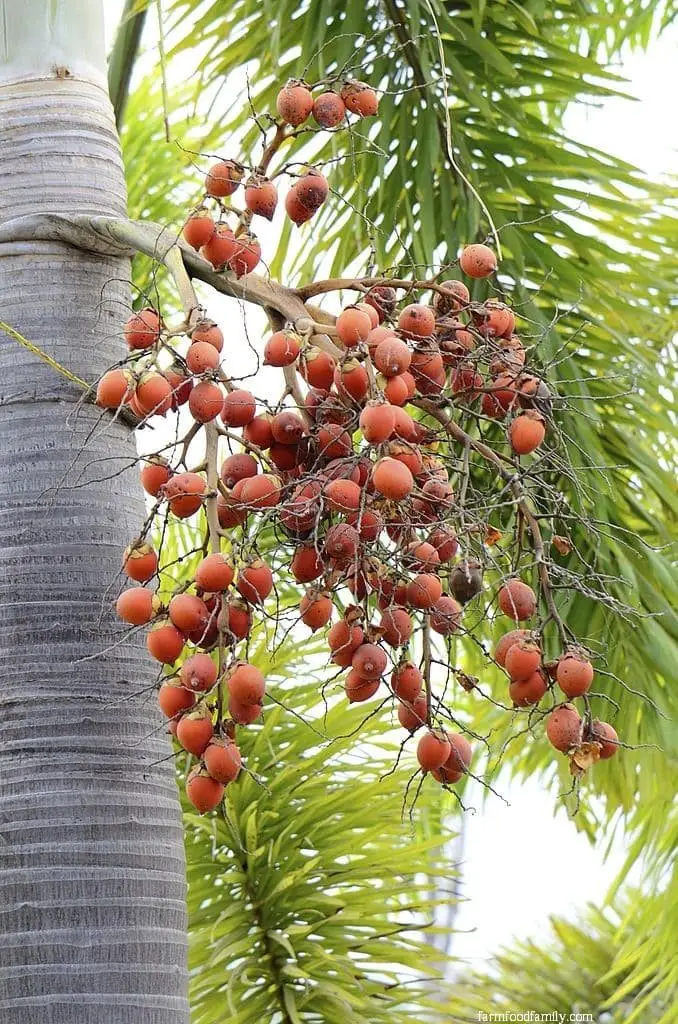
The Foxtail Palm, native to Australia but endemic in Florida, boasts a unique feature – its slivery-white trunk with arching fronds. The name ‘Foxtail’ stems from the branch growth habit, which resembles the distinctive plume of a fox’s tail. Characterized by its rapid growth rate, this palm can easily be mistaken for the Royal Palm, potentially reaching heights of up to 30 feet.
Keys thatch palm (Leucothrinax morrisii)

The Brittle Thatch Palm is characterized by its spiny, fan-shaped leaves that emerge from multiple branches on a single stem. This palm tree also boasts a fibrous trunk and small, white fruit. Native to Florida, it can be found growing between 3-36 feet tall. Notably, the Brittle Thatch Palm is cold-hardy, thriving in temperatures as low as -1C.
Latania Palm (Latania lontaroides)

The Silver-green Palm, also known as the Latan Palm, is widely distributed throughout south Florida. Its leaves are strikingly similar to those of Bismarck Palms, boasting a coarse texture and an upward growth habit. The fronds of this palm species grow in fan-shaped patterns that can reach up to 15 feet tall, with a mature height ranging from 20-30 feet.
Notably, the Latan Palm is well-suited for coastal environments due to its high salt tolerance, making it a common sight in parks and other areas along the coast.
Mexican Palm Tree (Washingtonia Robusta)

The Washingtonia robusta, also known as the Mexican washingtonia, is a unique palm species characterized by its distinctive palmate leaves, which grow up to 3 feet in length and form a fan-like shape. The plant’s foliage is leafy at the top, with a narrow, elongated trunk that can reach heights of up to 82 feet at maturity. One of its most notable features is the production of date-like fruits that are edible, although they lack the nutty flavor of true dates.
Montgomery Palm (Veitchia arecina)

The Vanuatu native palm tree exhibits moderate drought tolerance and is characterized by rapid growth. Its slender trunk bears a striking resemblance to the Christmas palm. The palm’s leaves are pinnate in nature, with a unique reduplicating feature that gives them a drooping appearance. In its natural habitat, this palm thrives in southwest Florida, where it can reach heights of up to 25-30 feet. Its feathered fronds add to its distinctive charm.
Needle Palm (Rhapidophyllum hystrix)

The needle palm, a compact yet striking ornamental option for landscapes, boasts a distinctive appearance that sets it apart from other palm species. Hailing from Florida, this hardy palm is particularly well-suited to thrive in the state’s climate, with its fan-shaped fronds curving outward to form a rounded crown at the base of the tree.
Notably, the needle palm features a sturdy trunk and grows to a relatively modest height of just 4ft, making it an attractive choice for gardens and landscapes where space is limited.
Parlor Palms (Chamaedorea elegans)

The pygmy date palm is characterized by its compact size and slender stems, which give it a reed-like appearance. Each stem bears 6-7 pinnate leaves that can create a lush, bushy effect. When grown outdoors, this palm typically reaches heights of around 9 feet, while indoor containers tend to cap out at about 6 feet. Its low-maintenance nature is also notable, as it can thrive in low-light environments and even tolerate complete darkness.
Paurotis Palm (Acoelorrhaphe Wrightii)

In the wild, the majestic plant thrives in Central America and Mexico, where it has developed a special affinity for dense, sandy soils. In Florida, it can be found growing near swamps, where its fronds stretch upwards, reaching lengths of up to 30 feet. The fan-shaped leaves are a stunning sight, extending some three feet from the stem. The trunk is characterized by fibrous mats with a distinctive red-brown hue, while the deep green leaves boast an attractive silver glow on their underside.
It’s worth noting that the plant produces fruits, but unfortunately they are not edible.
Piccabeen Palm (Archontophoenix cunninghamiana)
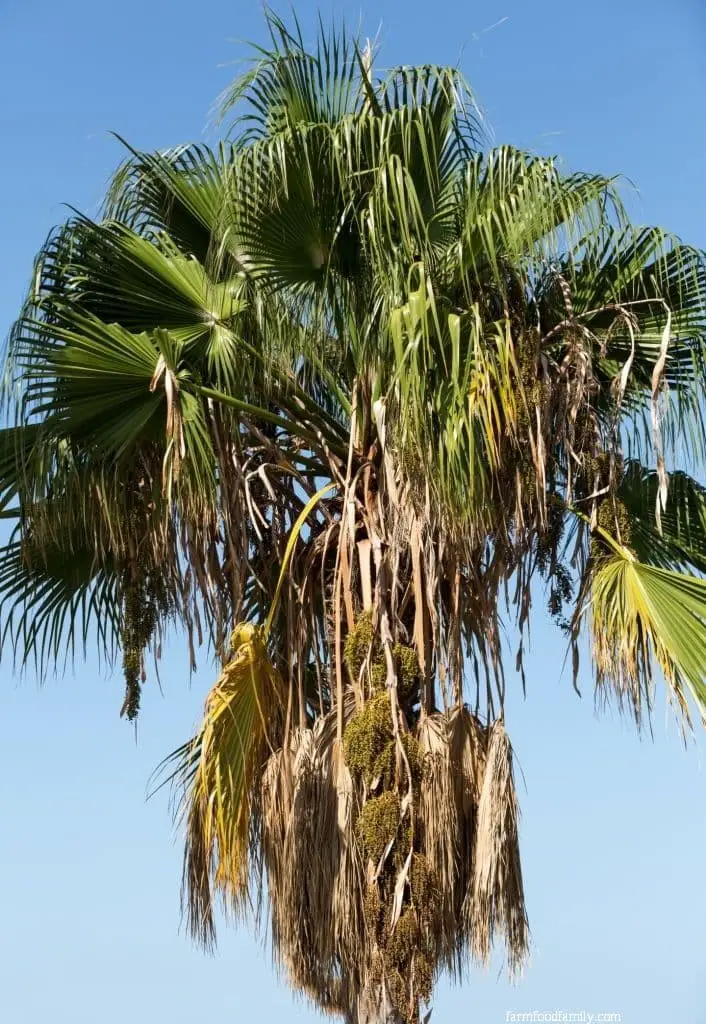
The Bangalow palm, also known as the King palm, is a native Australian species that boasts an array of attractive features. Its flowers are a vibrant purple hue, while its red fruits serve as a vital food source for birds and contribute to a balanced ecosystem. The palm’s leaf and branch structure bears a striking resemblance to that of the coconut palm, with the potential to reach heights of up to 60 feet.
Notably, this species is characterized by its multi-trunked growth habit and exhibits moderate cold hardiness, yet demonstrates remarkable wind tolerance.
Pindo Palm (Butia Capitata)

The jelly palm, a hardy and slow-growing species, can reach heights of up to 20 feet. Its ornamental value lies not only in its beauty but also in its ability to thrive in a variety of conditions. It is remarkably low-maintenance, tolerating partial shade and a range of soil types. This palms’ unique features include vibrant red, yellow, and white flowers, as well as orange to brown fruits that are harvested for use in making jellies, giving it its namesake.
Pygmy Date Palm (Phoenix roebelenii)

The Pygmy Date Palm, aptly named due to its maximum height of 10ft, boasts a unique identity through its long and luscious pinnate fronds and solitary stem. The fronds themselves take on an arched shape as they grow downwards. As a prized ornamental tree, this palm thrives in subtropical gardens, but it’s not limited to outdoor spaces – it can also be container-grown with ease.
One notable feature is the production of date-like fruits, though unfortunately, they’re not intended for human consumption.
Queen Palm (Syagrus Romanzoffiana)
In South America, a majestic ornamental palm thrives, boasting a rapid growth rate and reaching impressive heights of up to 50 feet with its single trunk. Its leaves are characterized by their glossy, pinnate shape, comprising multiple leaflets that form the crown. With a canopy coverage of approximately 25 feet, this palm tree is an ideal choice for landscape designs. During the summer season, it produces flowers, followed by the development of bright yellow, sticky fruits.
Red Sealing Wax Palm (Cyrtostachys renda)

The ‘Red-Stemmed’ plant boasts striking features that earn it its namesake. Its unique profile consists of vibrant red stems, a green, sock-like structure at the base, and an emerald green casing that houses the leaves as they unfurl from above. This species thrives in tropical to subtropical climates, typically reaching heights between 30-45 feet.
Ribbon Fan Palm (Livistona decora)

Characterized by its distinctive, ribbon-like foliage, the palm tree presents a unique appearance with its leaves drooping downwards to form a dense, umbrella-shaped crown. A native of Australia, it has also thrived in central and southern Florida, where it grows as an endemic species. Notably, this palm develops from a single stem, supported by a straight and smooth trunk that rises steadily into the air.
Royal Palm (Roystonea regia)

The majestic palm tree, renowned for its remarkable resilience, boasts an impressive lifespan of up to 100 years, defying harsh climate conditions with ease. Its distinctive curved leaves and ringed trunk make it a striking sight. This stalwart palm can grow up to 90ft in height, with its trunk reaching an astonishing 18ft, a testament to its enduring presence. Typically found thriving in the coastal regions of central and southern Florida.
Saw Palmetto (Serenoa repens)

A standout cultivar, this palm stands out with its distinctive fan-shaped leaves, spiky branches, and uniquely curved stem. Reaching a medium size of around 10ft, it thrives in Florida’s climate and demonstrates remarkable cold hardiness, tolerating temperatures as low as 6C. When it blooms, the result is a beautiful display of yellow-white flowers, followed by the ripening of dark red palm fruits.
Scrub Palmetto (Sabal etonia)

One of the most distinctive features of the scrub palmetto is its unique leaf structure, characterized by fan-shaped fronds branching out from a slender stem. This cold-hardy species has a remarkable ability to thrive in temperatures as low as -12°C, making it an excellent choice for landscaping in Florida and other regions with similar climates. The palm’s bright yellow-green leaves and curved growth habit make it an ideal groundcover option, growing up to 7 feet tall.
Silver Bismarck Palm (Bismarckia nobilis)

The Baillon’s palm, named after its namesake and the first German Chancellor, has found a new home in Southern Florida, where its love of moderately moist and well-draining soil has allowed it to naturalize with ease. This majestic palm can grow up to 40 feet tall, with a sturdy trunk measuring a robust 18 inches in diameter. Its striking silver-green leaves are truly impressive, reaching lengths of up to 4 feet.
What’s more, this palm is an ideal choice for landscapes, as it is remarkably low maintenance due to its slow growth rate. Once the roots are established, the Baillon’s palm can even tolerate cooler temperatures, withstanding temperatures as low as -9.5°C.
Sylvester Palm (Phoenix sylvestris)
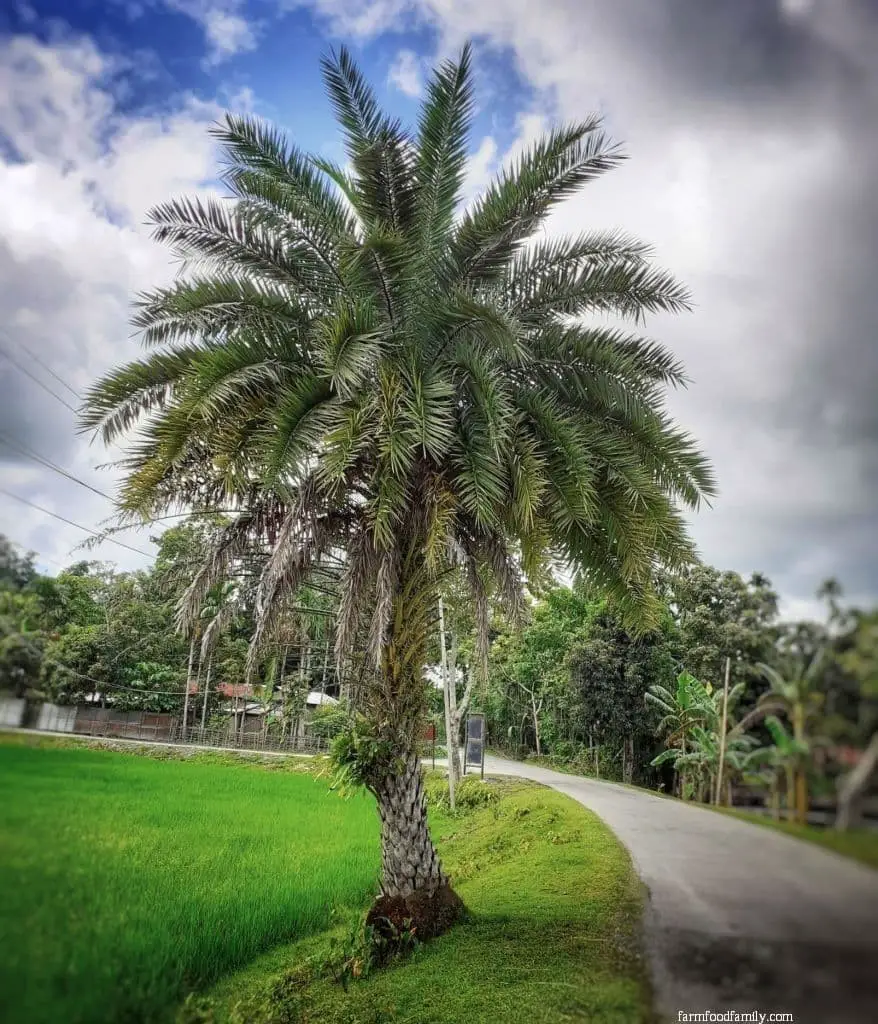
Native to Asian countries such as Pakistan, India, and Nepal, this palm species has a close genetic relationship with the Canary Island palm. Its growth habits are varied, with some specimens reaching heights of up to 50 feet, while smaller varieties can reach as low as 13 feet in height. A defining characteristic of this palm is its unique leaf structure, featuring large, pinnate, and arching leaves that emerge from a single stem.
Windmill Palm (Trachycarpus Fortunei)
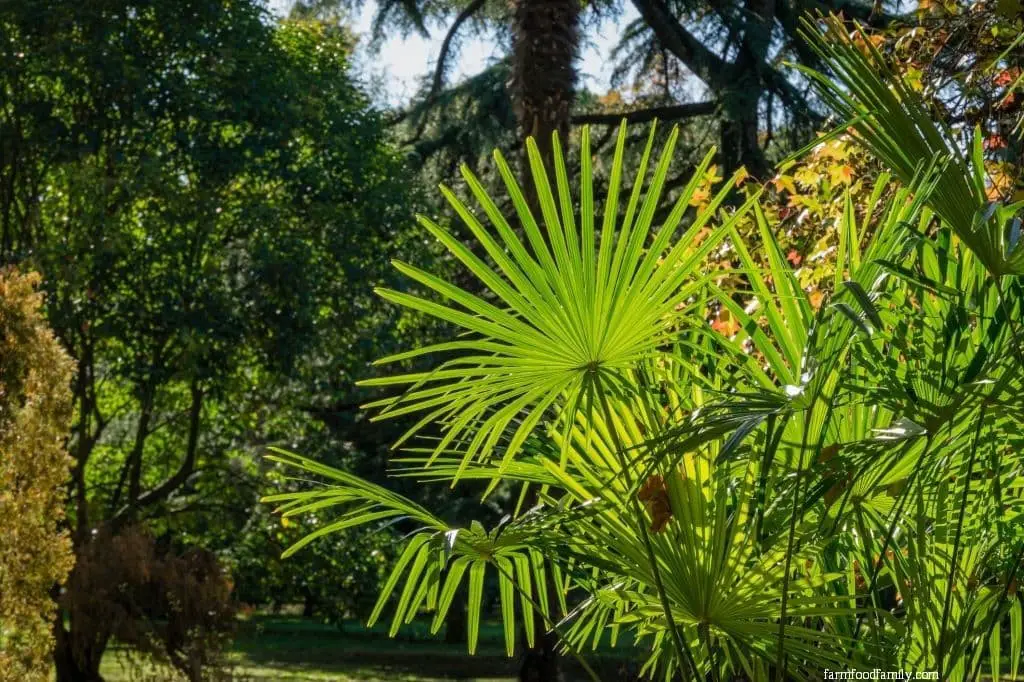
The Windmill Palm’s origins can be traced back to China and Japan, where it thrives as a hardy native species. Its unique palmate leaves, shaped like a fan and radiating outward in seemingly random directions, evoke the image of a windmill. This resilient palm tree can grow up to 66 feet tall, supported by a long, slender trunk that allows it to reach new heights.
FAQs
Why are there no coconuts on palm trees in Florida?
While it’s true that certain species of palm trees do indeed produce coconuts, a notable exception can be found in Florida – where the tropical climate lends itself perfectly to their growth. However, despite this ideal environment, coconuts are no longer as ubiquitous as they once were in Florida. The reason behind this shift lies not with the palms themselves, but rather with the devastating impact of whitefly infestations on these trees.
The voracious appetites and rapid reproduction rates of these pests have taken a significant toll on the palm populations, making them less visible than they once were.
What is the most expensive palm tree in Florida?
The Coco de Mer palm tree holds a unique distinction in the world of palms, being not only the most expensive in Florida but also the most valuable globally. This majestic tree can grow up to 110 feet tall and requires an astonishing 40 years of growth before it produces its first flowers. When considering purchasing one of these rare specimens, be prepared for a significant investment – a 6-foot Coco de Mer palm tree can cost upwards of $330.
How long do palm trees live in Florida?
Palm trees in Florida have a lifespan that varies depending on their species. On average, they can live for around 80 years, although hybrid types may only reach an age of up to 40 years. In contrast, hardy species can thrive for over a century, with some individuals living well beyond 100 years. For those interested in witnessing the majesty of these ancient plants, Naples is a must-visit destination – often referred to as the ‘palm tree capital’ of Florida.
What is the fastest growing palm tree in Florida?
The Carpentaria palm stands out as one of the most impressive palms, boasting the distinction of being the fastest-growing palm tree in Florida. Reaching full maturity in a remarkably short period of 5-6 years, this medium-sized palm is a true marvel. Interestingly, it shares a common ancestry with its cousin, the Veitchia species. While both are native to Australia, they have long since adapted to their new environment in South Florida.
What city in Florida has the most number of palm trees?
Naples boasts an impressive palm tree population, as we’ve highlighted before. Official statistics reveal that the city is dominated by palm trees, with a staggering 13,000 palms standing tall in 2018 alone. In contrast, only 7,000 hard and softwood trees call Naples home, showcasing the significant disparity between the two.
Which other US states have the most number of native palm trees?
While it’s undeniable that Florida boasts the highest number of native palm species, other states shouldn’t be overlooked. In fact, several regions in the United States are home to an impressive array of palm varieties. Some notable mentions include Texas, California, Hawaii, Arizona, Georgia, Louisiana, and North and South Carolina.
What are the most famous landscape palms in Florida?
Within the realm of palms, a specific subset consists of just five species that warrant attention. These are the Pygmy date palm, the Areca palm, the Christmas palm, the Foxtail palm, and the European fan palm, all of which possess unique characteristics that set them apart from others in their category.
Conclusion
Palm trees are a true marvel of nature, boasting an impressive global presence and ability to thrive in unexpected regions. One of the states where they particularly flourish is Florida, which boasts some of the most majestic palm tree specimens in the United States. When considering all that we’ve explored, a drive-by tour of Florida’s stunning palms should undoubtedly be at the top of your bucket list, awaiting immediate attention.
Related Posts
When it comes to online plant nurseries, variety is key. From the majestic apple trees to evergreens that provide year-round interest, there’s a wide range of options available. But have you ever wondered how arborists become experts in tree care? Or what impact trees can have on a property? Whether you’re looking to boost your home’s appeal or are interested in growing your own organic blueberries, this article will cover it all.
For those who want to take their love of trees to the next level, becoming an arborist is a unique career path that requires a combination of scientific knowledge and physical skill. Meanwhile, the right tree can greatly enhance a property’s aesthetic appeal, while removing unwanted ones can also make a big difference.






